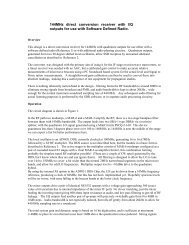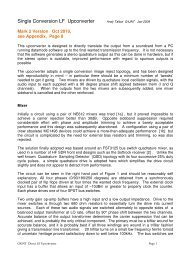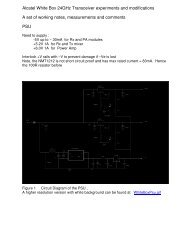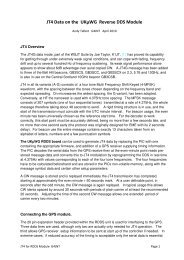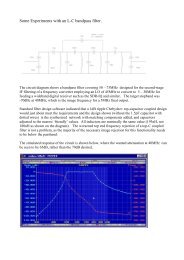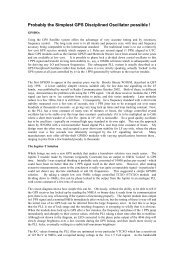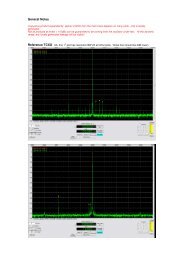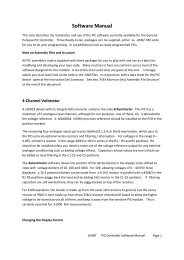The WSPR Coding Process I wanted a simple way of ... - G4JNT
The WSPR Coding Process I wanted a simple way of ... - G4JNT
The WSPR Coding Process I wanted a simple way of ... - G4JNT
You also want an ePaper? Increase the reach of your titles
YUMPU automatically turns print PDFs into web optimized ePapers that Google loves.
N 1 = [Ch 1]<br />
N 2 = N 1 * 36 + [Ch 2]<br />
N 3 = N 2 * 10 + [Ch 3]<br />
N 4 = 27 * N 3 + [Ch 4] – 10]<br />
N 5 = 27 * N 4 + [Ch 5] – 10]<br />
N = 27 * N 1 + [Ch 6] – 10]<br />
<strong>The</strong> first character can take on any <strong>of</strong> the 37 values including<br />
[sp] but the second character cannot then be a space.<br />
<strong>The</strong> third character must al<strong>way</strong>s be a number, so only 10 values are possible.<br />
Characters at the end cannot be numbers,<br />
so only 27 values are possible.<br />
Giving an absolute maximum value for N <strong>of</strong> 37 * 36 * 10 * 27 * 27 * 27 = 262177560<br />
Which is just comfortably less than 2 28 = 268435456 and means the callsign can be represented by<br />
28 bits with a range <strong>of</strong> codes left over for the future, eg. For allocation to special cases and flags.<br />
Locator<br />
Designating the four locator characters as [Loc 1] to [Loc 4], the first two can each take on the 18<br />
values ‘A’ to ‘R’ only so are allocated numbers from 0 – 17. <strong>The</strong> second pair can take only the<br />
values 0 – 9.<br />
Another integer M is formed from:<br />
M 1 = (179 - 10 * [Loc 1] - [Loc 3] ) * 180 + 10 * [Loc 2] + [Loc 4]<br />
Which gives a range <strong>of</strong> values from ‘AA00’ = 32220 to ‘RR99’ = 179, which comfortably fit into a<br />
15 bit representation (2 15 = 32768), leaving spare codes for further enhancements.<br />
Power level, [Pwr] is taken as a value from 0 – 60. Although only certain values will work with the<br />
WSJT / <strong>WSPR</strong> s<strong>of</strong>tware (just those ending in 0, 3 or 7) any <strong>of</strong> the possible 61 values will be<br />
encoded; Illegal values are labelled when decoded. Power in encoded into M by :<br />
M = M 1 * 128 + [Pwr] + 64 Which gives a final range <strong>of</strong> values for M up to a maximum <strong>of</strong><br />
4124287, and fits into 22 bits ((2 22 = 4194304)<br />
Bit Packing<br />
<strong>The</strong> total source data has now been reduced to 50 bits <strong>of</strong> data; 28 for the callsign in N with 15 for the<br />
locator and 7 for the power in M. A few special cases <strong>of</strong> coding are available for future<br />
enhancements like text messages, but these are not be covered here.<br />
<strong>The</strong> two integers N and M are truncated and combined so the 50 bits sit end-to-end as callsignlocator-power.<br />
<strong>The</strong>se are placed into an array <strong>of</strong> eleven 8-bit bytes c[0] to c[10], so the first element<br />
c[0] contains the most significant 8 bits part <strong>of</strong> the callsign, c[1] the next 8 bits and so on. (Note that<br />
c[3] contains both the 4 LSBs <strong>of</strong> the callsign and 4 MSBs <strong>of</strong> the locator, and that c[6] contains just<br />
the two LSBs <strong>of</strong> M occupying the most significant bit positions. <strong>The</strong> lowest six bits <strong>of</strong> c[6] are set<br />
to 0, with the remaining byte-array elements [c7] to c[10] set to zero. Only the left-most 81 <strong>of</strong><br />
these 88 total bits are subsequently used.<br />
An alternative view is to imagine them as an 81 character-long string containing characters ‘0‘ and<br />
‘1’ only.<br />
Convolutional Encoding



